Jul 21, 2017
The Battle of Dunkirk was one of the most devastating moments for Allied Forces in World War II, resulting in nearly 400,000 British, French and Dutch troops being trapped on a beach outside the French seaport town. With the treacherous waters of the English Channel before them and fears of overwhelming German forces coming to wipe them out by land, they needed to be evacuated.
The unexpected problem was that large rescue ships could not handle the shallow waters near shore, so the call went out from the British government for smaller boats to help save the day. At the same time, the Germans inexplicably decided to stop their land advance and rely on their Luftwaffe air force to kill off the Allies, inadvertently allowing more time for the rescues to occur.
The heroism shown by civilians in saving the soldiers, and the troops' battle to survive while waiting for help, forms the heart of writer-director Christopher Nolan's harrowing new epic, "Dunkirk." Nolan applies the time-bending techniques he has become famous for in such films as "Memento" and "Inception" to thrust viewers straight into the action on land, sea and air by constantly interweaving three different storylines.
The film first follows a young British soldier named Tommy (Fionn Whitehead) as he runs for his life through the streets of Dunkirk, before reaching the beach and being shocked by the sight of the men waiting for rescue. With hundreds of thousands lined up on beaches or trapped on an extended jetty called "The Mole" under the concerned eye of Commander Bolton (Kenneth Branagh), Tommy manages to board a boat but soon finds it under attack as well.


